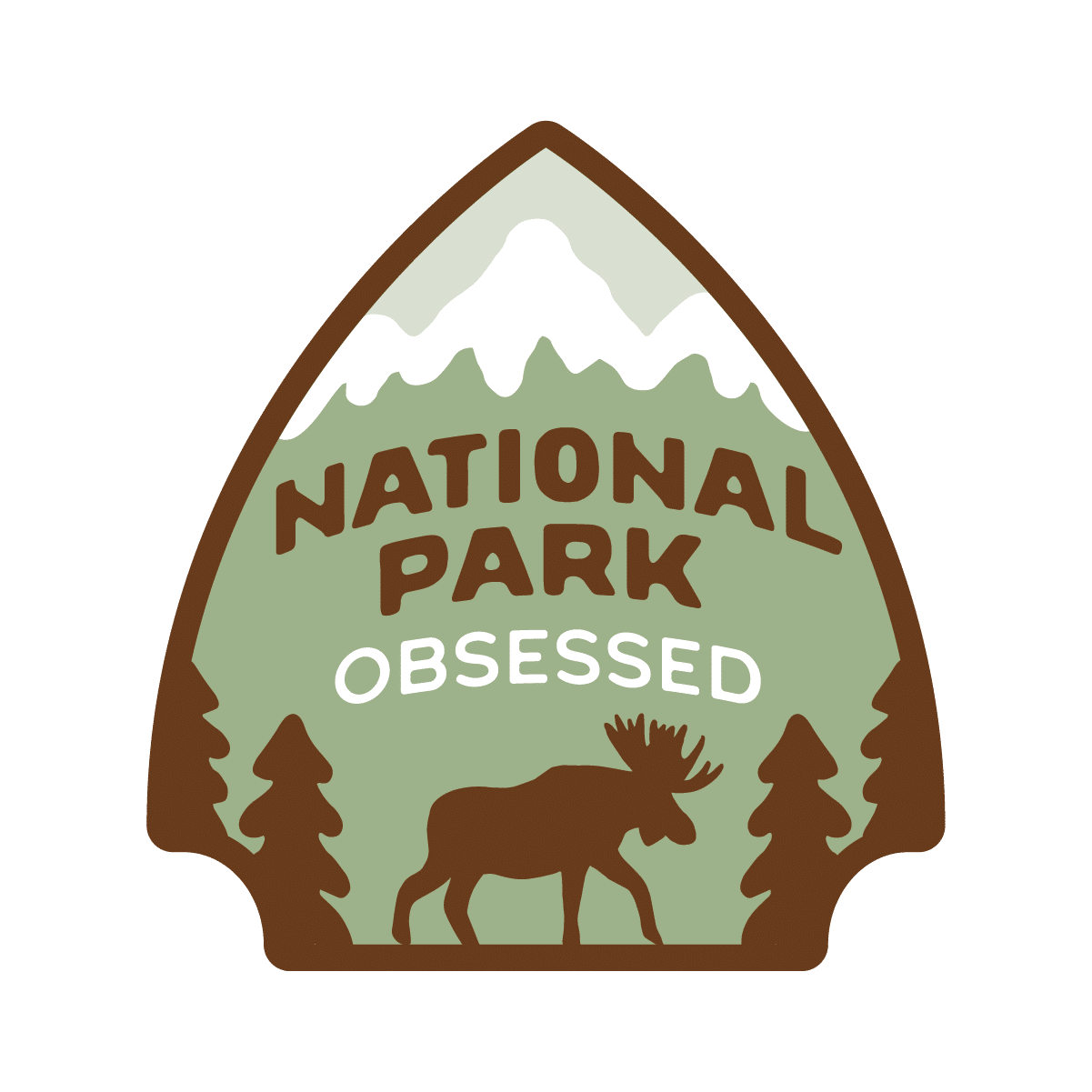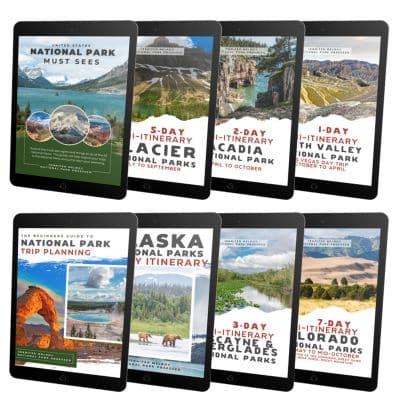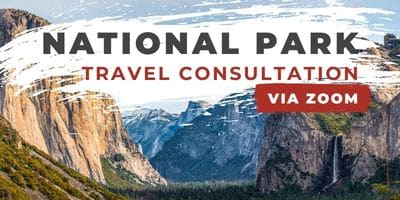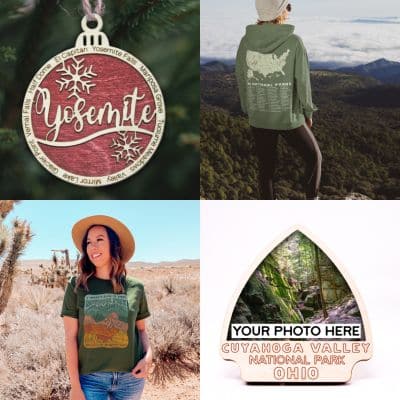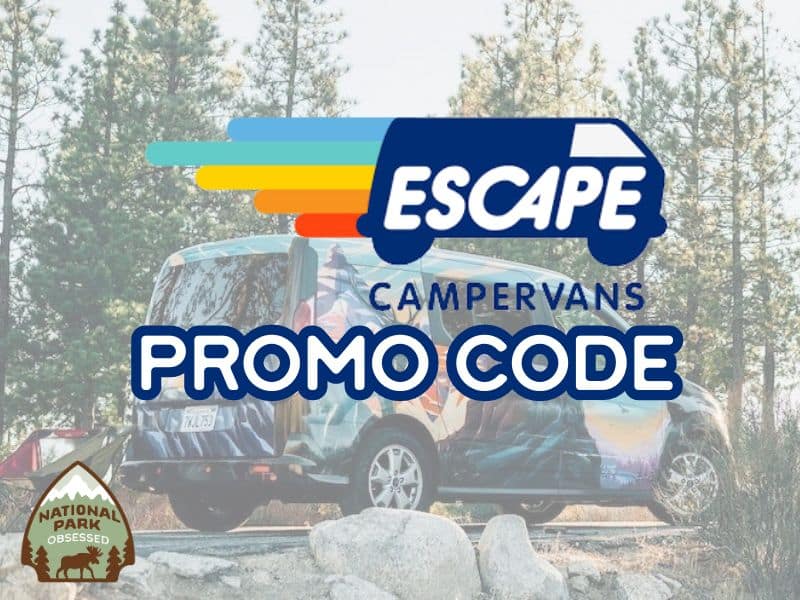
Escape Camper Vans Promo Code
- Jennifer Melroy
- Last Modified June 7, 2025
- First Published on June 6, 2024
Have you been road tripping in the National Parks out west and seen a colorful van in the parking lot? It’s rare that I’m in a California, Utah, or Arizona National Park and don’t see at least one. I’ve been seeing them for years, and every time I do, I think to myself. I’ve got to try one.
After nearly 100,000 miles of road tripping across the US from Florida to Alaska and many places in between, I’ve got my car camping setup pretty dialed in, but that only works if I’ve time and want to start and end the trip in Knoxville, Tennessee.
So, back in March, Escape Camper Vans reached out about National Park Week, and we went from that to a road trip from Orlando, Florida, to Phoenix, Arizona. Less than four weeks later, I flew down to Florida and met up with Megan from Red Around the World, and off we went on an almost 4,400-mile adventure through six states and 17 National Park Service sites.
This post is sponsored by Escape Camper Vans. They graciously loaned me one of their vans for this review, but all thoughts and opinions are my own. This post may contain affiliate links, meaning if you book or buy something through one of these links, I may earn a small commission at no extra cost to you! Read the full disclosure policy here
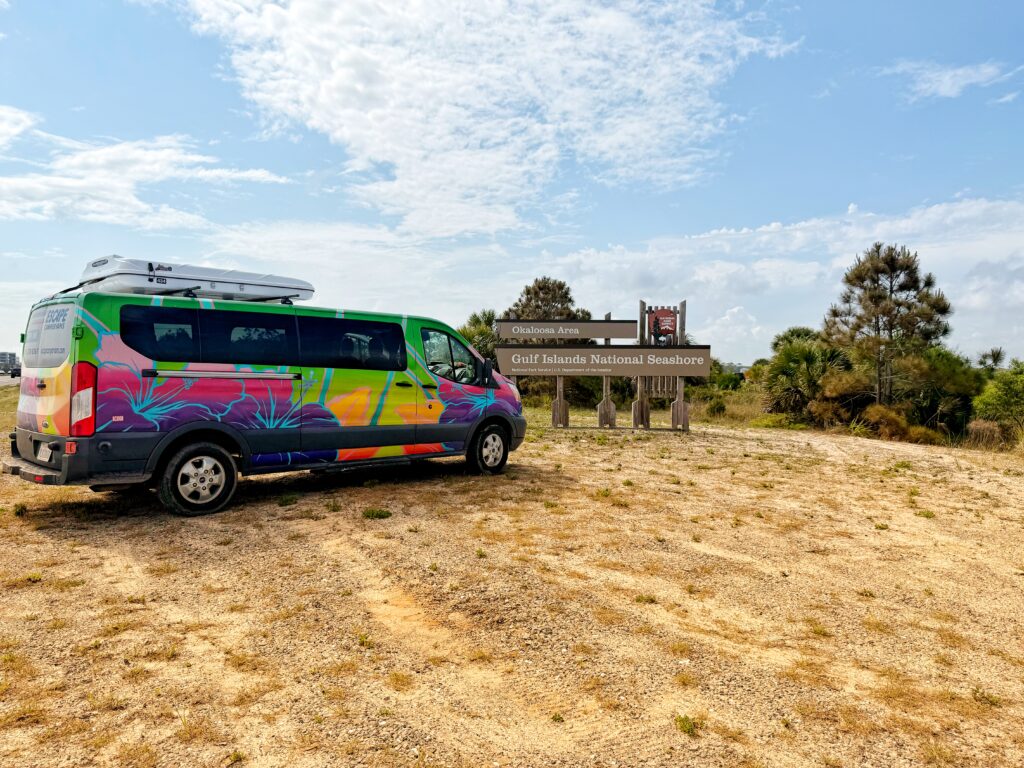
Escape Camper Van Review
As I mentioned earlier, Escape Camper Vans lent me one of their Mesa camper vans for this trip. The Mesa is one of their slightly larger van options.
About our Mesa Camper Van
- Queen-sized in the back
- A fixed row of seats
- Outdoor accessible kitchen
- Two-burner propane stove (ours was a green Coleman one.)
- Pump handle sink
- Five-gallon water tank for the sink (Not potable)
- One-drawer fridge (ours was a Dometic CD 30)
- Solar light
- Three cubbies to store food
- A small interior table for use when the bed isn’t in use
- Bench seating for when the bed isn’t in use
- Three cigarette lighters for charging
- An uncountable number of cup holders
- Three storage drawers under one of the wide benches
- A “ski locker” under the smaller bench
- Extras (at an additional cost)
- Bedding Kit
- Bug socks (to cover the front windows and keep the bugs out when not moving)
- Two cans of propane
- Kitchen Kit
- Rooftop Tent
- Camp chairs
- Picnic Table
- Tarp Sun Shade
Our Trip
Our trip wasn’t what I would call a typical Escape Camper Van trip. Part of the trip involved relocating a van to help Escape Camper Vans out for the summer season, and the other part was that I really wanted to visit Poverty Point in Louisiana, the Waco Mammoth Site in Texas, and tour the New Mexico NPS sites I hadn’t been to. Plus, we had a much larger block of time than the average American on vacation.
In total, we spent 17 days and 16 nights driving from Orlando to Phoenix. We visited six states, 17 National Park Service sites, two UNESCO World Heritage Sites, one hot spring, and one state park. We spent 6 nights in campgrounds and boondocked for 10 nights. We drove approximately 4,400 miles, which was an average of 4-5 hours a day, getting from one place to another and our campsite.
For the most part, I never felt like we were in a rush, but we did move at a good clip. We even had time to fit in a few unplanned stops and scenic drives.
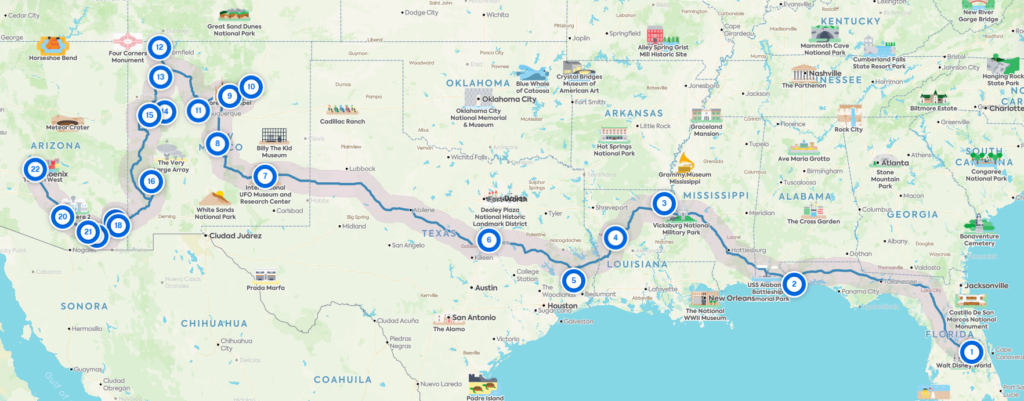
My Thoughts on Escape Camper Van
This was my first time renting a camper van, and I wasn’t sure how it would go. It didn’t help that, on top of planning this road trip less than a month in advance, this would be the first time Megan and I had met in person. I was probaly more nervous about that than the van. I was hoping that my road trip planning skills would translate into camper van trip planning.
After 17 days of travel, I’m happy to report that camper van trip planning is pretty much the same as road tripping in my SUV, except for needing to know the height and length of one’s vehicle. Thankfully, Escape Camper Vans fit in regular parking spaces, so they can pretty much fit in any campsite with minimal backing-up skills.
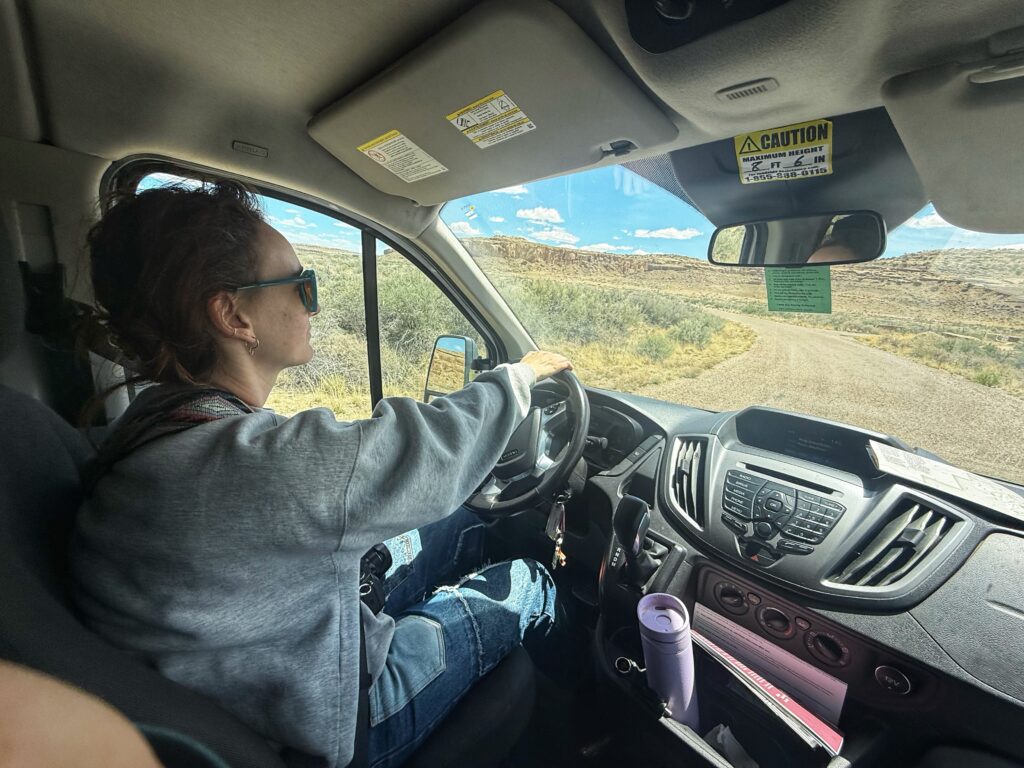
My biggest concern with the van was my travel companion. I knew I could handle driving the van. I had plenty of experience backing up my dad’s full-size pickup and occasional boat trailer, but I wasn’t sure about Megan’s skill set. My original plan was for us to pick up the van, and I’d ease Megan into driving the van on the interstates and highways of rural Florida.
American Airlines had other ideas, and my flights were delayed, so Megan had to pick up the van by HERSELF and pick me up at the airport by herself. It was an 8.4-mile drive on FL-528, through south Orlando. She was nervous, but found it pretty similar to driving her sedan, except that we sat higher.
She did trade off and let me drive once we finished my half of the paperwork. For most of the trip, I handled the city driving and did most of the backing up. Megan was fine doing it if needed, butt she was more than willing to make me do the driving in higher traffic areas. We make a point of parking in the back of the lots, away from other cars, and pulling through spaces when possible. You can’t hit anything backing up if you aren’t backing up.
I’ve always been a last-minute, fly-by-the-seat-of-my-pants traveler, and this trip was no different. Megan and I created our itinerary, and it was fairly set in stone. For the most part, the plan was to boondock camp everywhere except Chiricahua National Monument. I used the Dyrt app to pre-scout dispersed camping areas and campgrounds. We prebooked camping at Chiricahua and Gila Hot Springs (which I found while scouting our driving route).
The van handled everything we threw at it, and we certainly put it through its paces and tested it getting out to a number of gravel roads for boondocking. Be sure to check the weather before heading up some of these roads and where possible check the road conditions before heading up these roads.
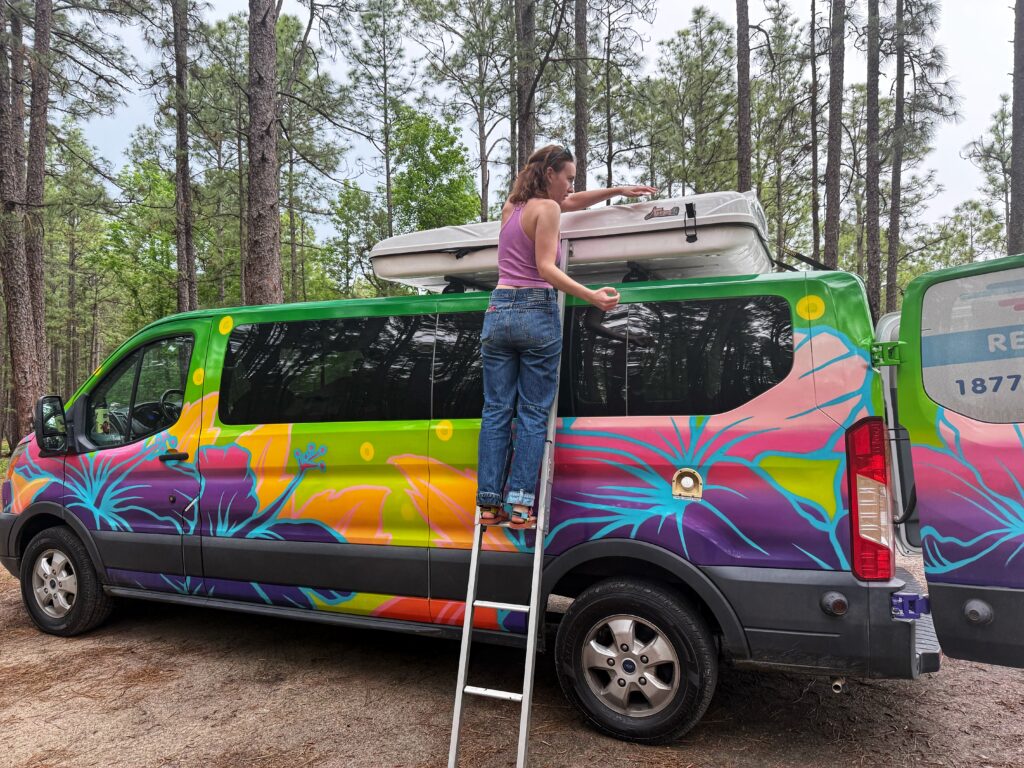
The original plan was for Megan to sleep in the rooftop tent (additional fee), and I would sleep in the back of the van. But we quickly discovered a slight problem. Both Megan and I are under 5’5″, and getting the rooftop tent closed was hard. We had to get a little creative to get everything latched properly before moving on. So we just shared the queen bed in the back. With three or four people or one taller person, the rooftop tent is probaly much easier to use.
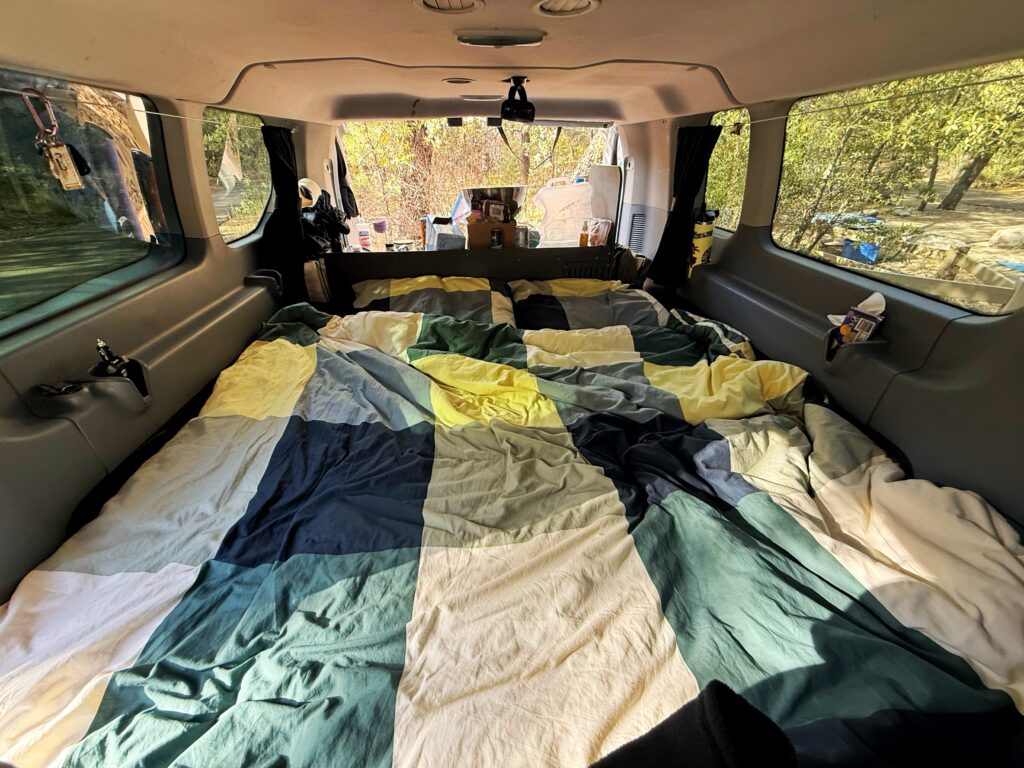
There was a slight learning curve in setting up the bed. First, we had to determine where the latches were and unlatch them. Then we had to figure out how to lift the bed platform slightly to pull it out fully. Once we figured that out, and how to position ourselves to get the best leverage to lift the bed, we were good to go. I recommend getting the bedding kit (additional cost) so you don’t have to bring bedding with you.
The biggest flaw in the fan is the lack of ventilation in the back of the van. It was partially bad while we were in the land of humidity (aka Florida & Louisiana). Once we got into West Texas, things got a lot better because the humidity was lower and the nights got into the 40s.
None of the back windows open, and there is no way to get any airflow in the van. If you get the bug socks (additional cost), you can leave the front windows open, which helps a little, but not significantly. I’m so thankful, I threw my USB-powered portable fan in so we could get some air moving in the back.
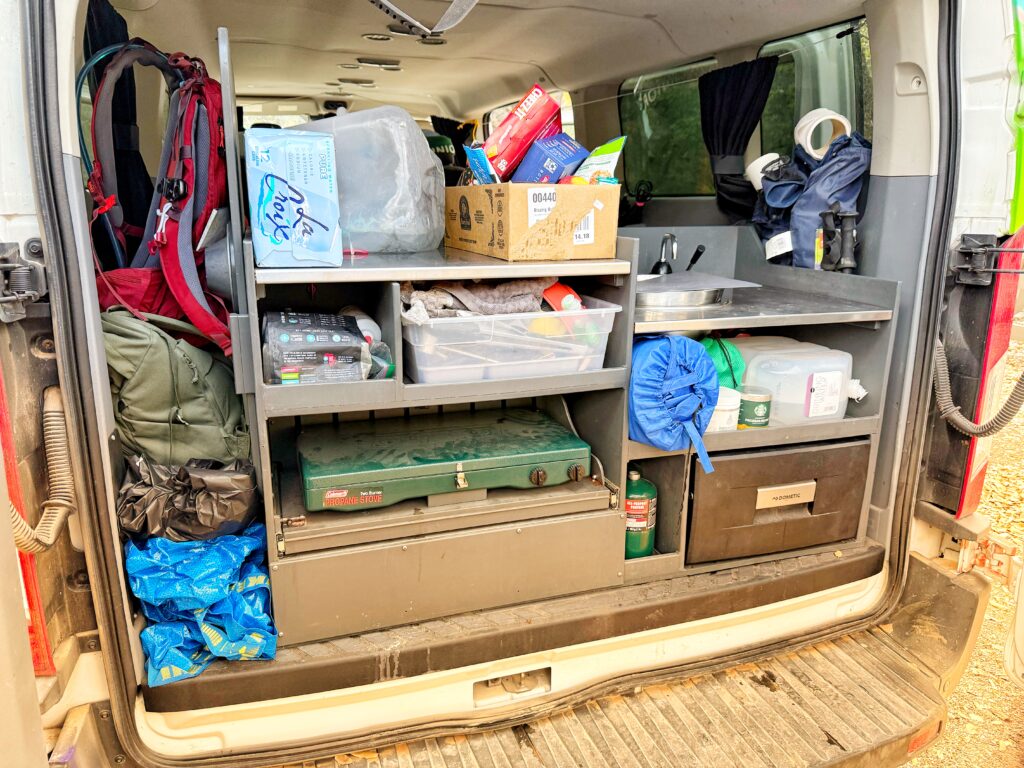
The kitchen set-up was almost perfect. A two-burner Coleman camping stove slides out, and you hook it up to the propane tank; you are then ready to cook. The fridge is a Dometic CD 30 with one cu ft of space. Most days, we heat water for hot beverages and hot cereal for breakfast. Then have cold cuts for lunch and cook a one- or two-pot dinner. For dinner, we mostly made a mix of noodles, cheese, and a protein. We used two cans of propane during our 17-day trip.
The van has a small sink with a 5-gallon fresh water tank. The water is non-potable, meaning it is not suitable for drinking. We had to fill the grey water tank every 5 days or so. For drinking water, I brought my 5-gallon water jug and would refill it every couple of days. We also picked up two gallons of bottled water as a backup for the first couple of days.
On average, we stopped for groceries every two to three days. The longest we went between grocery shopping was 4 days, and I had to play Tetris to fit all the cold food in. That did require some forward thinking and more careful meal planning, but we managed to make it work. It didn’t really feel like we were constantly worrying about how much space we had for food. It might be a little different with more than two people, but if you stick to easy-to-cook and simple meals, it’s doable.
Probably the best thing we acquired during our trip was the box sitting on the top of the counter. It made a great dry storage area since there isn’t a lot of shelving, and it was easy to pull out and look through when picking road snacks.
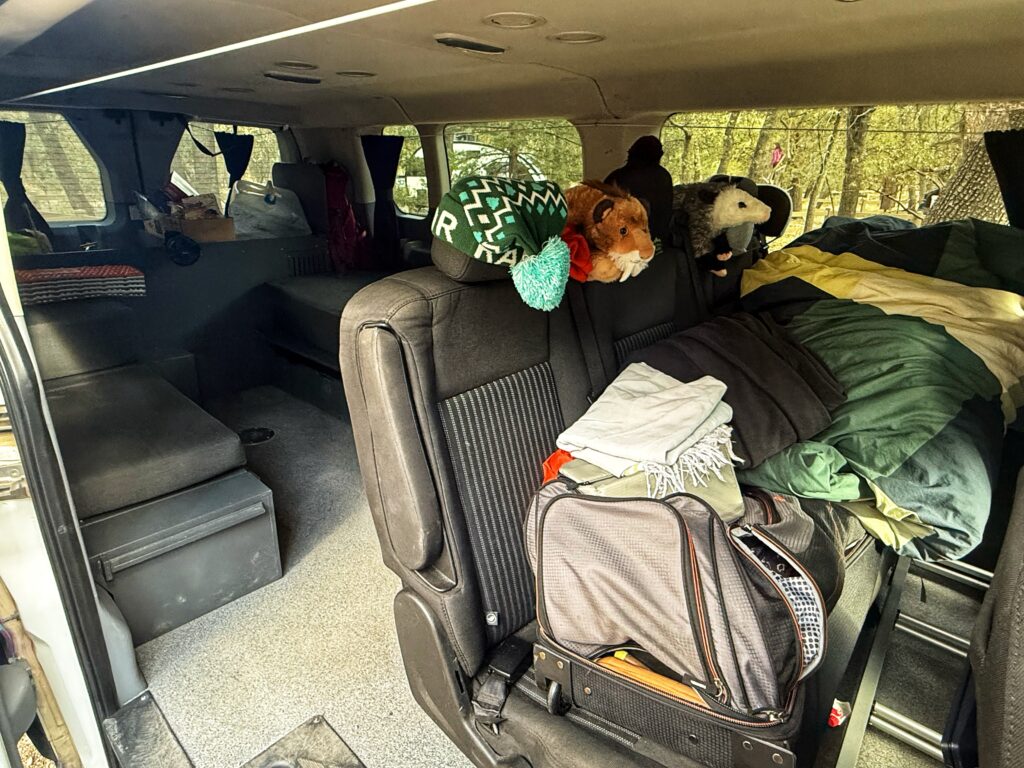
We kept most of our clothing in the drawers under the bed, and left our bags sitting on the back seat. Remember to lock the drawers after getting something out. I can’t count how many times we forgot, but it was a regular recurrence.
One thing I didn’t realize was how handy the number of cup holders in the vehicle is. They were a great place to store smaller items that you needed regularly, particularly up front. Sure, we kept water bottles in them, but we kept everything from toothbrushes to writing materials.
When the bed isn’t set up, there are two benches and an optional table. The table is a bit wobbly, but at various points and times, we both had our computers out on the table and didn’t have an issue working.
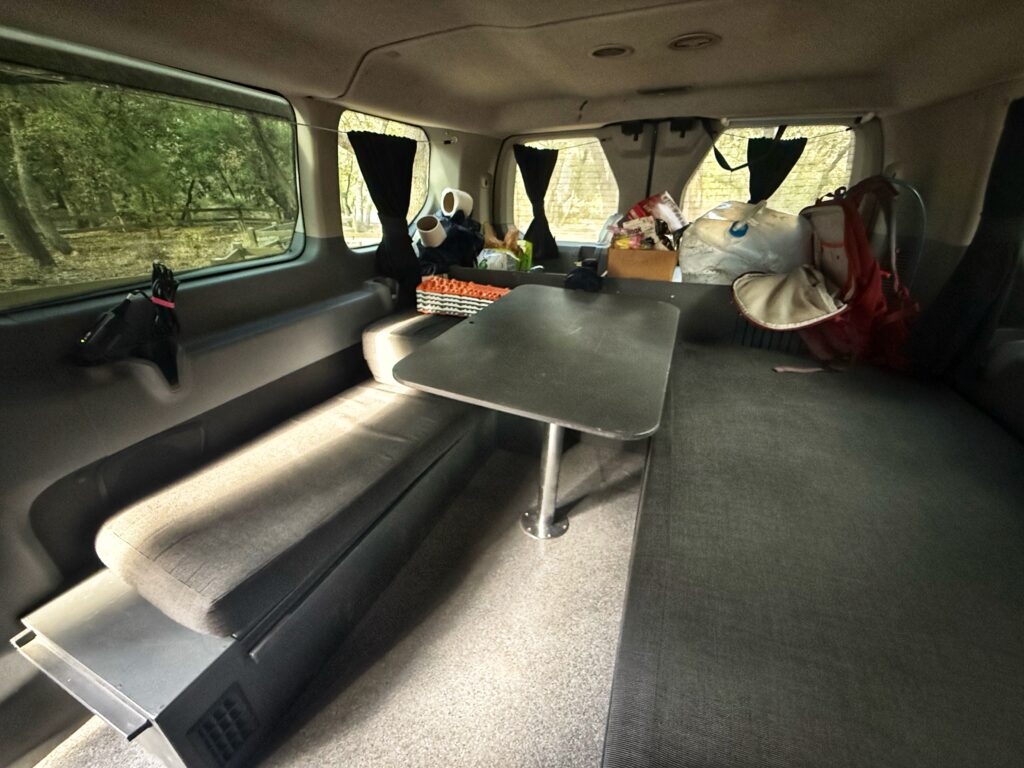
Between the two of us, we had two laptops, two phones, two cameras, and multiple charging banks. It took some careful management to keep us in power, especially on days we need the computers to work. If you aren’t driving 4+ hours a day, it is probably much harder to keep all your electronics powered (then again, if you aren’t travel bloggers, you are probably on vacation and don’t need to work on the road.)
If it were just our phones, cameras, and the charging bank for my USB-powered fan, we’d have probably been fine even with driving significantly less. The van had three cigarette lighters. Two were up front and one was in the back. I brought my outlet charger and a USB charger. Our van also came with a second USB charger (I’m not sure if that was standard or if it was left by someone else). Between the chargers, we had plenty of power.
Who is a camper van rental good for?
Pretty much anyone can rent these vans. They are very beginner-friendly, and you can drive a sedan, you can drive these vans, just take your time backing up.
I think the ideal renters for Escape Camper Vans are pairs or couples. If you have a group of three or four friends or a family with more than one child, you may want to consider a rooftop tent or renting a Del Mar van. I wouldn’t recommend renting this van if you have five adults or three teens and two adults.
Megan and I were two people, and we had plenty of room, so we didn’t have to play musical chairs very often. With larger groups, you will likely need to be more organized with your belongings and may need to frequently move luggage from the rear seats to the back.
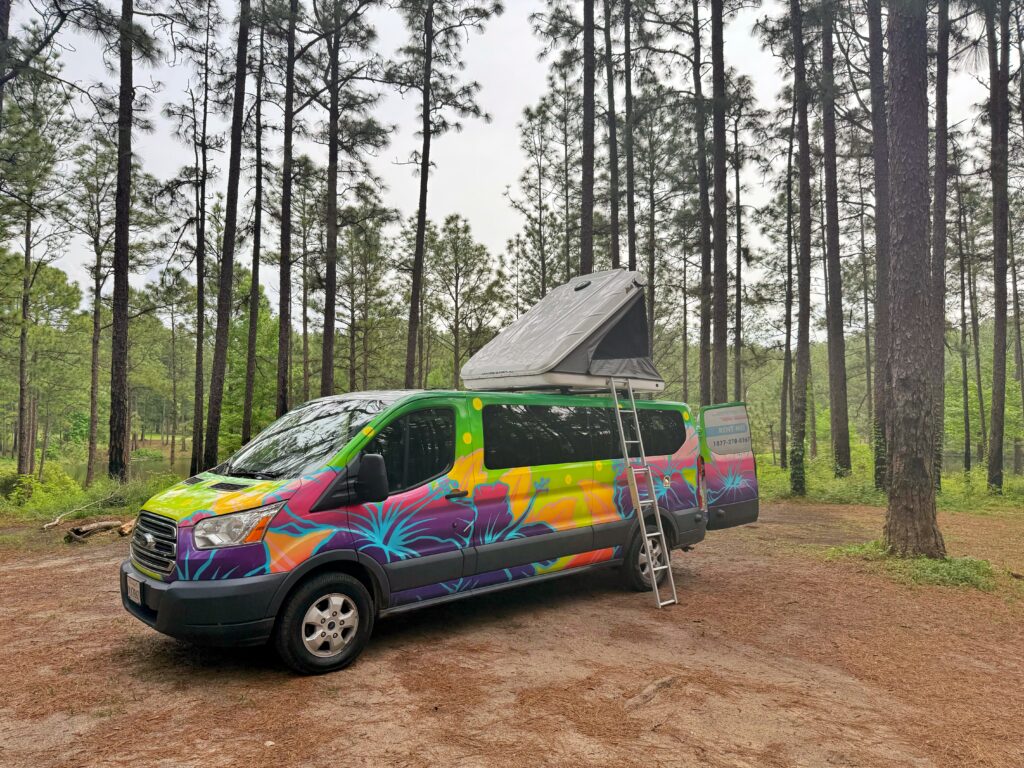
Is an Escape camper van worth it?
Yes, but it is a premium option, more akin in price to staying in hotels than to camping. The Escape Camper Van rental fee is comparable to that of budget hotels in most locations. You get about half as many miles per gallon as a rental car, and the camper van has a mileage fee. But you have a kitchen, so you don’t have to eat out. You can cook on the go and have a refrigerator, allowing you to keep things cold and enjoy a wider range of food options. You get all the flexibility of staying in the park campgrounds without having to sleep on the ground.
Due to the mileage fees, it’s probaly not worth it cost-wise to do a cross-country road trip, but for a loop in California, the Southwest, Utah, or the Pacific Northwest, it would be perfect.
I will definitely be looking at renting an Escape Camper Van next time I’m flying out west for a shorter National Park Road Trip.
National Park Obsessed members get
Jennifer Melroy
Hi, I'm Jennifer!
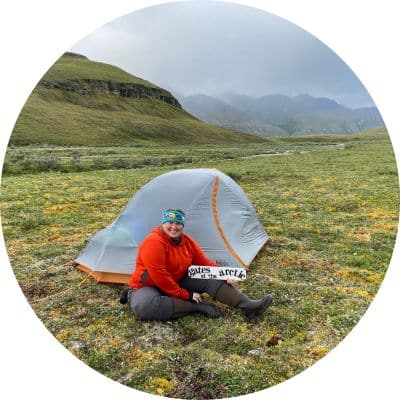
Welcome to the wonderful world of National Parks. I'm here to help you plan your NEXT amazing adventure through the United States National Parks and beyond. I want the national parks to be accessible to all.
I live in Tennessee, and when I'm home, you can find me hiking in the Smokies and the Cumberland Plateau.
58/63 National Parks
250+/423 National Park Units
Want to know more? Start Here.
ACKNOWLEDGEMENT OF LAND
On this site, we promote travel to the United States and beyond that are the traditional lands of Indigenous and First Nations peoples.
With respect, I make a formal land acknowledgment, extending my appreciation and respect to these lands’ past and present people.
To learn more about the people who call these lands home, I invite you to explore Native Land.
DISCLAIMER
National Park Obsessed assumes no responsibility or liability for any errors or omissions in the content of this site (NationalParkObsessed.com). The information contained in this site is provided with no guarantees of completeness, accuracy, usefulness or timeliness. You are encouraged to conduct your own due diligence before acting on the information provided on this site and should not rely on the opinions expressed here.
There is an inherent risk in all outdoor recreation activities, the reader assumes all responsibility for their own personal safety.
DISCLOSURE
We are a participant in the Amazon Services LLC Associates Program, an affiliate program designed to provide a means for us to earn fees by linking to Amazon.com and affiliated sites.
Privacy Policy • About Us • Contact
Select stock photography provided depositphotos
Copyright ©2023 National Park Obsessed, LLC
Privacy Overview
Last Updated on 7 Jun 2025 by Jennifer Melroy
